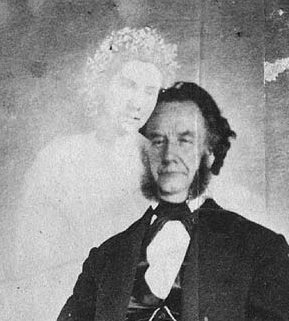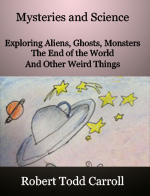From Abracadabra to Zombies
ghosts
In a nutshell: Ghosts are spirits of dead people. Scientists have tried for centuries to prove ghosts exist. The evidence for ghosts includes photos, eyewitness accounts, and performers who say they are getting messages from ghosts to pass on to people. Scientists don't think much of this evidence.
Ghosts are spirits of dead people. Most people who believe in spirits think they are not physical but yet are able to do things that people can do, like see, hear, move around, and make sounds. Can something that isn't a body do the same kinds of things that bodies can do? It doesn't seem possible, yet many people say they've seen ghosts and talked to them. Others say that ghosts exist only in the imagination. Some say that ghosts exist and they are physical, but we don't know what they're made of. One thing is certain: there are lots of ghost stories.
ghost stories
One favorite kind of ghost story has ghosts haunting houses, graveyards, or old buildings. Some people say they can "feel" the presence of ghosts, but it is hard to tell whether such people just feel weird because they expect a ghost to be there. Others say they feel it getting colder in spots where ghosts hang out. Many say they hear strange creaking noises or other sounds they think are signs of ghosts.
 These people are not imagining things. Most hauntings happen in old buildings, which tend to be drafty. Scientists who have gone to haunted places to study them say that the temperature changes and the sounds are probably caused by such things as empty spaces behind walls or wind currents set in motion by low frequency sound waves (infrasound
These people are not imagining things. Most hauntings happen in old buildings, which tend to be drafty. Scientists who have gone to haunted places to study them say that the temperature changes and the sounds are probably caused by such things as empty spaces behind walls or wind currents set in motion by low frequency sound waves (infrasound![]() ) produced by fans. (Elephants communicate over distances of several miles by infrasound, which can be felt but not heard by humans, and which can be measured by sound recorders. Infrasound waves can be felt and cause things to vibrate, which might make some people think there are ghosts present. They see something moving but don't see anything making it move.)
) produced by fans. (Elephants communicate over distances of several miles by infrasound, which can be felt but not heard by humans, and which can be measured by sound recorders. Infrasound waves can be felt and cause things to vibrate, which might make some people think there are ghosts present. They see something moving but don't see anything making it move.)
Scientists investigating haunted houses have also found that many ghost noises are made by animals such as squirrels, birds, and rats. Other sounds are made by the wind blowing through cracks or holes.
why do ghosts show up only at night or in dark places?
Why should ghosts care whether it is day or night? They don't have to work or go to bed early so they'll be fresh for school the next day. Maybe it's easier for people to find the source of a weird sound or sight in broad daylight. People see more ghosts at night because people can't see what might really be going on.
It's usually cooler and breezier at night. Many things make creaking noises as they cool down. The breezes can make scary sounds and move things. The imagination is more likely to run wild in the dark than in the sunlight. Things always seem more mysterious at night. Many people are afraid of the dark because they can't see what's really going on around them. Fear is fuel for the imagination.
talking to ghosts
Some people try to talk to ghosts by getting together around a table in a dark room. They call such a meeting a séance![]() . The leader of the séance is called a medium
. The leader of the séance is called a medium![]() . A medium is someone who says he can get ghosts to come to the room to give signs to living people that the ghost is real. These meetings never take place in broad daylight. Scientists who have looked into séances say that they are held in the dark because it is easier to trick people that way. The medium or his assistant can produce objects, move things, or make noises and speak in a mysterious voice, while the others can't see what anyone is doing. Many mediums have been caught cheating.
. A medium is someone who says he can get ghosts to come to the room to give signs to living people that the ghost is real. These meetings never take place in broad daylight. Scientists who have looked into séances say that they are held in the dark because it is easier to trick people that way. The medium or his assistant can produce objects, move things, or make noises and speak in a mysterious voice, while the others can't see what anyone is doing. Many mediums have been caught cheating.
Séances were popular for a long time, but today many people who say they are mediums don't use any props and they work on a stage. They don't have their ghosts ring bells or float things across the room, as was done in many séances. Today's mediums just say things, claim they are getting messages from the dead, and wait for others to make sense out of what they say. A medium might say to an audience "somebody's grandmother is here." It is up to people in the audience to figure out what the medium means. One person might be young and think the medium means that his grandmother's ghost is in the room. Another might be old and think he means her granddaughter's ghost is in the room. If one of the people in the room speaks up, the medium will say something else and wait for the person to make sense out of it. Scientists call this process of making sense out of questions or statements raised by a total stranger subjective validation![]() . Many people come away from such meetings believing they have been in contact with the ghost of a loved one. Many others think the medium is just playing with people's emotions and isn't getting any messages from the dead.
. Many people come away from such meetings believing they have been in contact with the ghost of a loved one. Many others think the medium is just playing with people's emotions and isn't getting any messages from the dead.
What does science have to say about today's mediums? Some have been studied and caught cheating, but it is impossible to prove that dead people aren't making noises that some mediums hear. We have the mediums' word for it, but if they are cheating their word is worthless.
poltergeists
Poltergeists are ghosts that cause all kinds of trouble around the house. The word poltergeist![]() means literally "noisy spirit." These ghosts break things, throw things around, make all kinds of noises, and sometimes even start fires. Investigators of poltergeists have found that some of the most famous cases have been due not to ghosts, but to unhappy or bored teenagers. One famous case was found to be due to the wind blowing down through a chimney.
means literally "noisy spirit." These ghosts break things, throw things around, make all kinds of noises, and sometimes even start fires. Investigators of poltergeists have found that some of the most famous cases have been due not to ghosts, but to unhappy or bored teenagers. One famous case was found to be due to the wind blowing down through a chimney.
Investigators of poltergeists have found that some items that people think move on their own are actually thrown. People often think they see what they did not actually see. Also, the shape of our outer ear makes it hard for us to locate the precise source of a sound.
In one famous poltergeist case, if the investigators weren't looking for it and didn't have a camera on her, they might never have found out that a teenage girl was knocking things over and claiming that they just jumped to the floor.
photographs of ghosts
Many people have photographs that look like ghosts are in them. Some of these "ghosts" are reflections of light off the camera lens. Some are not. When you take a picture using film that has already been used to take a picture, you get both pictures combined into one. If you know how to develop photographs you can print one picture on top of another and make the two pictures look like one. These days it is easy to make ghost photos. You just buy a program for your computer like Photoshop and have some fun.

people who see ghosts
If you think you've seen a ghost, you are not alone. Many people think they've seen ghosts. Seeing a ghost can be quite scary. Most likely what happens when a person sees a ghost is that the brain takes whatever fuzzy information it gets from the eyes, ears, and other senses and thinks there is some sort of being out there that is intentionally moving the way it is or making the sounds it is making. We call beings that can direct their own movements intentional agents![]() . It is common for humans to think that objects that are not agents, such as branches of trees moving in the wind, are intentional agents when they're not. Once you know that what you saw and heard was the wind blowing some branches, you stop thinking of ghosts. But if you never get a chance to see clearly what it was that your brain turned into a ghost, you can't be sure that what you saw wasn't a ghost. What you saw, though, was probably created by your imagination. You might say that when you are scared by seeing a ghost, you are scaring yourself. Why? Because your brain is probably fooling you and you are not seeing a real ghost out there in real space. Anyway, that is what the science tells us.
. It is common for humans to think that objects that are not agents, such as branches of trees moving in the wind, are intentional agents when they're not. Once you know that what you saw and heard was the wind blowing some branches, you stop thinking of ghosts. But if you never get a chance to see clearly what it was that your brain turned into a ghost, you can't be sure that what you saw wasn't a ghost. What you saw, though, was probably created by your imagination. You might say that when you are scared by seeing a ghost, you are scaring yourself. Why? Because your brain is probably fooling you and you are not seeing a real ghost out there in real space. Anyway, that is what the science tells us.
Last updated


